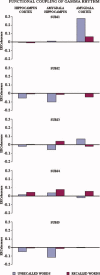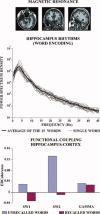Hippocampal, amygdala, and neocortical synchronization of theta rhythms is related to an immediate recall during rey auditory verbal learning test
- PMID: 18819109
- PMCID: PMC6871026
- DOI: 10.1002/hbm.20648
Hippocampal, amygdala, and neocortical synchronization of theta rhythms is related to an immediate recall during rey auditory verbal learning test
Abstract
It is well known that theta rhythms (3-8 Hz) are the fingerprint of hippocampus, and that neural activity accompanying encoding of words differs according to whether the items are later remembered or forgotten ["subsequent memory effect" (SME)]. Here, we tested the hypothesis that temporal synchronization of theta rhythms among hippocampus, amygdala, and neocortex is related to immediate memorization of repeated words. To address this issue, intracerebral electroencephalographic (EEG) activity was recorded in five subjects with drug-resistant temporal lobe epilepsy (TLE), under presurgical monitoring routine. During the recording of the intracerebral EEG activity, the subjects performed a computerized version of Rey auditory verbal learning test (RAVLT), a popular test for the clinical evaluation of the immediate and delayed memory. They heard the same list of 15 common words for five times. Each time, immediately after listening the list, the subjects were required to repeat as many words as they could recall. Spectral coherence of the intracerebral EEG activity was computed in order to assess the temporal synchronization of the theta (about 3-8 Hz) rhythms among hippocampus, amygdala, and temporal-occipital neocortex. We found that theta coherence values between amygdala and hippocampus, and between hippocampus and occipital-temporal cortex, were higher in amplitude during successful than unsuccessful immediate recall. A control analysis showed that this was true also for a gamma band (40-45 Hz). Furthermore, these theta and gamma effects were not observed in an additional (control) subject with drug-resistant TLE and a wide lesion to hippocampus. In conclusion, a successful immediate recall to the RAVLT was associated to the enhancement of temporal synchronization of the theta (gamma) rhythms within a cerebral network including hippocampus, amygdala, and temporal-occipital neocortex.
Copyright 2009 Wiley-Liss, Inc
Figures







References
-
- Aggleton JP,Brown MW ( 1999): Episodic memory, amnesia, and the hippocampal‐anterior thalamic axis. Behav Brain Sci 22: 425–444, discussion 444–489. - PubMed
-
- Asaka Y,Griffin AL,Berry SD ( 2002): Reversible septal inactivation disrupts hippocampal slow‐wave and unit activity and impairs trace conditioning in rabbits (Oryctolagus cuniculus). Behav Neurosci 116: 434–442. - PubMed
-
- Basar E,Basar‐Eroglu C,Karakas S. Schurmann M ( 2001) Gamma, alpha, delta, and theta oscillations govern cognitive processes. Int J Psychophysiol 39: 241–248. - PubMed
-
- Bastiaansen M,Hagoort P ( 2003): Event‐induced theta responses as a window on the dynamics of memory. Cortex 39: 967–992. - PubMed
MeSH terms
LinkOut - more resources
Full Text Sources
Medical

